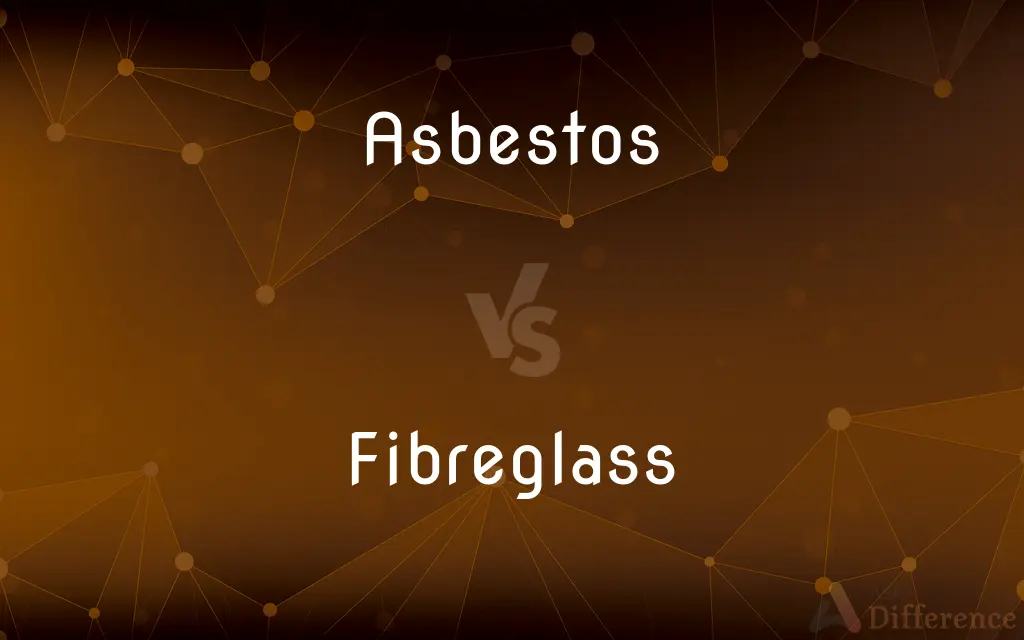Asbestos vs. Fibreglass — What's the Difference?
Edited by Tayyaba Rehman — By Fiza Rafique — Updated on April 24, 2024
Asbestos is a natural silicate mineral known for its heat resistance and durability, while fibreglass is a synthetic fiber, prized for its lightweight and insulation properties.

Difference Between Asbestos and Fibreglass
Table of Contents
ADVERTISEMENT
Key Differences
Asbestos is a naturally occurring mineral that has been used extensively in construction for its fire resistance and insulating abilities. In contrast, fibreglass is a man-made material composed of fine glass fibers, used similarly for its insulation and non-flammable properties.
Asbestos fibers are strong and resistant to chemicals and heat, making them ideal for use in high-temperature environments. On the other hand, fibreglass also exhibits resistance to heat but tends to be less durable in chemical-heavy environments compared to asbestos.
One of the significant risks associated with asbestos is its health hazard when inhaled, as its tiny fibers can cause severe respiratory issues, including cancer. Whereas fibreglass is generally considered safer, though it can still irritate the skin, eyes, and respiratory tract upon contact.
In terms of environmental impact, asbestos disposal is heavily regulated due to its hazardous nature, requiring special handling and disposal techniques to avoid contamination. Conversely, fibreglass involves less rigorous disposal methods, though it is not biodegradable and still poses environmental challenges.
Asbestos use has declined significantly due to health risks, leading to bans in many countries. In contrast, fibreglass remains widely used in various applications, including insulation, automotive parts, and recreational items, benefiting from its relative safety and versatility.
ADVERTISEMENT
Comparison Chart
Composition
Natural silicate minerals
Synthetic glass fibers
Heat Resistance
High
Moderate to high
Chemical Resistance
Very high
Moderate
Health Risks
High (carcinogenic when inhaled)
Lower (irritation of skin and lungs)
Environmental Impact
Requires special disposal methods
Easier disposal, not biodegradable
Compare with Definitions
Asbestos
Carcinogenic material.
Asbestos exposure has been linked to various lung diseases.
Fibreglass
Non-flammable.
Fibreglass is preferred in construction for its fire resistance.
Asbestos
Known for its durability.
Asbestos fibers are highly durable and resistant to chemical degradation.
Fibreglass
A material made from extremely fine fibers of glass.
Fibreglass is often used for thermal insulation in buildings.
Asbestos
A fibrous silicate mineral.
Asbestos was commonly used in building materials for its fire-resistant properties.
Fibreglass
Recyclable.
Unlike asbestos, fibreglass can be recycled, reducing its environmental footprint.
Asbestos
Requires special handling.
Asbestos removal must be conducted by certified professionals to avoid health risks.
Fibreglass
Can cause irritation.
Handling fibreglass requires protective gear to prevent skin and lung irritation.
Asbestos
Banned or restricted in many countries.
The use of asbestos is now banned in over 50 countries worldwide.
Fibreglass
Used in a variety of products.
Fibreglass is used in boat manufacturing due to its lightweight and strength.
Asbestos
Asbestos (pronounced: or ) is a naturally occurring fibrous silicate mineral. There are six types, all of which are composed of long and thin fibrous crystals, each fibre being composed of many microscopic "fibrils" that can be released into the atmosphere by abrasion and other processes.
Fibreglass
Silica based glass extruded into fibers that possess a length at least 1000 times greater than their width.
Asbestos
Any of six incombustible chemical-resistant silicate minerals, including one serpentine (chrysotile) and five amphiboles (amosite, crocidolite, and fibrous forms of actinolite, anthophyllite, and tremolite), that separate easily into long, thin, flexible fibers and that have been widely used commercially in products such as fireproofing, electrical insulation, building materials, brake linings, and chemical filters. Mining and use of asbestos has been restricted because inhalation of asbestos fibers can cause asbestosis and cancer.
Fibreglass
Ellipsis of fibreglass wool
Asbestos
Fabric or material containing any of these mineral forms.
Fibreglass
A composite material made from fine fibres of spun glass held together with resin.
Asbestos
Of, made of, or containing one of these six mineral forms.
Fibreglass
To apply fibreglass to.
To fibreglass the hull of a fishing-boat
Asbestos
(mineral) Any of several fibrous mineral forms of magnesium silicate, used for fireproofing, electrical insulation, building materials, brake linings, chemical filters, suits, fireman's gloves, etc.
All types of asbestos are potentially carcinogenic when inhaled.
Asbestos insulation was once ubiquitous.
Fibreglass
Same as fiberglass.
Asbestos
(mineral) Any of asbestos-like forms of several minerals, asbestiforms
Fibreglass
A covering material made of glass fibers in resins
Asbestos
To coat or line with asbestos.
Asbestos
To expose to asbestos; to cause to suffer asbestosis.
Asbestos
(metaphoric) To insulate or buffer.
Asbestos
A fibrous amphibole; used for making fireproof articles; inhaling fibers can cause asbestosis or lung cancer
Common Curiosities
What is fibreglass?
Fibreglass is a synthetic fiber made from a type of glass that is extruded into thin strands.
Are both materials used for insulation?
Yes, both asbestos and fibreglass are used for their thermal and acoustic insulating properties.
Is fibreglass safe to use?
While generally safer than asbestos, fibreglass can still cause irritation to the skin, eyes, and lungs if not handled properly.
What is asbestos?
Asbestos is a natural mineral made up of thin, fibrous crystals.
Why is asbestos considered dangerous?
Asbestos fibers can be inhaled and permanently lodged in the lungs, causing diseases such as mesothelioma.
Can asbestos be used in new construction?
In many countries, the use of asbestos in new construction is banned or highly regulated.
How is fibreglass made?
Fibreglass is made by melting glass and spinning it into fine fibers.
What regulations exist for asbestos?
Asbestos is heavily regulated with strict guidelines for handling, removal, and disposal.
What are common uses of fibreglass?
Fibreglass is used in insulation, automotive parts, and as a reinforcing agent in many plastic products.
How are asbestos and fibreglass different in terms of health risks?
Asbestos poses serious health risks including cancer, whereas fibreglass primarily causes irritation.
What are the disposal considerations for asbestos?
Asbestos waste requires careful disposal to prevent airborne contamination and exposure.
Share Your Discovery

Previous Comparison
Concave vs. Convex
Next Comparison
Town vs. VillageAuthor Spotlight
Written by
Fiza RafiqueFiza Rafique is a skilled content writer at AskDifference.com, where she meticulously refines and enhances written pieces. Drawing from her vast editorial expertise, Fiza ensures clarity, accuracy, and precision in every article. Passionate about language, she continually seeks to elevate the quality of content for readers worldwide.
Edited by
Tayyaba RehmanTayyaba Rehman is a distinguished writer, currently serving as a primary contributor to askdifference.com. As a researcher in semantics and etymology, Tayyaba's passion for the complexity of languages and their distinctions has found a perfect home on the platform. Tayyaba delves into the intricacies of language, distinguishing between commonly confused words and phrases, thereby providing clarity for readers worldwide.














































